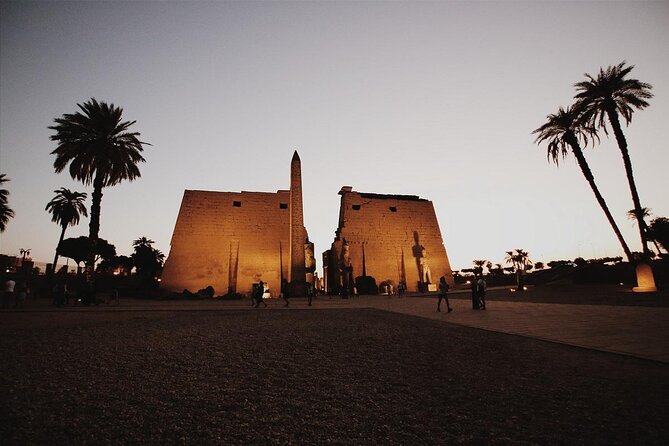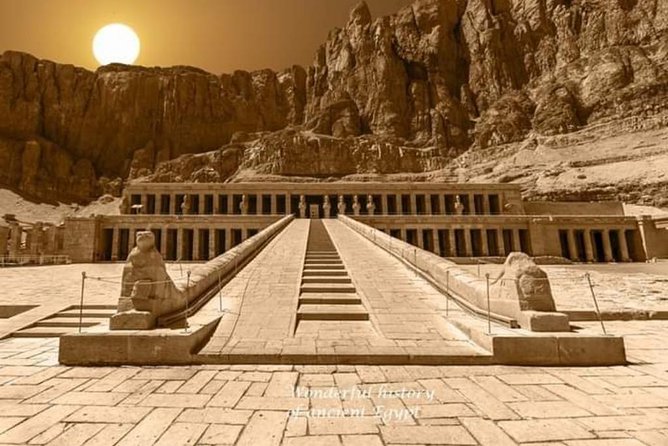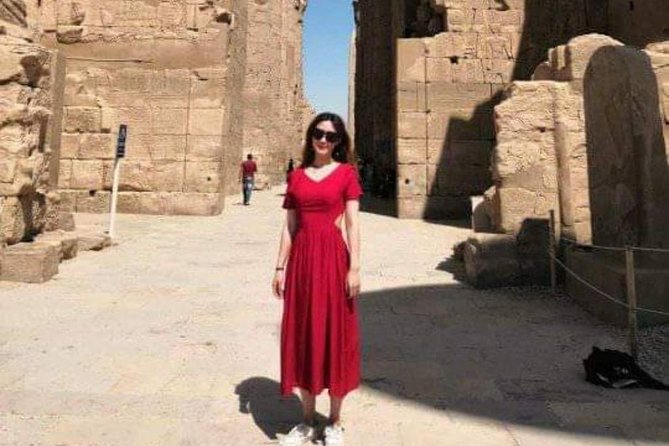Exploring the Hatshepsut Temple and the Valley of the Kings, one uncovers layers of ancient Egyptian history that continue to captivate scholars and travelers alike. The temple, dedicated to one of Egypt’s few female pharaohs, stands as a testament to her legacy, while the nearby Valley of the Kings houses the final resting places of legendary rulers, replete with intricate hieroglyphics and rich stories. These sites not only reveal the grandeur of ancient civilization but also raise intriguing questions about power, gender, and beliefs. What secrets might these storied locations still hold?
Key Points

- Hatshepsut Temple, a 15th-century BCE mortuary site, showcases the achievements of Egypt’s few female pharaohs and honors the goddess Hathor.
- The Valley of the Kings, a royal burial ground, contains tombs of pharaohs, including the famous King Tutankhamun, rich in treasures and murals.
- The Valley of the Queens features over 90 tombs, offering insights into royal women’s lives and beliefs about the afterlife, including the tomb of Queen Nefertari.
- Guided tours are available for both sites, providing historical context and enhancing the visitor experience with intricate details about ancient Egyptian culture.
- Practical tips include visiting early, dressing comfortably, staying hydrated, and capturing photos during the golden hour for the best experience.
Historical Significance of Hatshepsut Temple

The Hatshepsut Temple, also known as the Mortuary Temple of Hatshepsut, stands as a remarkable testament to the achievements of one of Egypt’s few female pharaohs.
Built in the 15th century BCE, this architectural marvel showcases the ingenuity of ancient Egyptian design. Its terraced structure, harmoniously integrated into the surrounding cliffs, symbolizes Hatshepsut’s divine right to rule.
The temple served not just as a memorial but also as a center for worship dedicated to the goddess Hathor.
Intriguing reliefs depict Hatshepsut’s successful trade expeditions and her claim to the throne, challenging traditional gender roles of the time.
Today, the temple remains a crucial link to understanding the complexities of gender and power in ancient Egypt, drawing visitors from around the globe.
You can also read our reviews of more tours and experiences in Luxor.
Exploring the Valley of the Kings

Nestled on the west bank of the Nile, the Valley of the Kings offers a mesmerizing glimpse into the grandeur of ancient Egyptian burial practices. This famed site served as a royal burial ground for pharaohs and powerful nobles during the New Kingdom period.
Visitors can explore the intricately designed tombs, each showcasing exquisite hieroglyphics and stunning murals that depict the deceased’s journey to the afterlife. Among the most notable tombs is that of King Tutankhamun, which continues to captivate audiences with its treasures.
Guided tours provide insights into the historical context, ensuring an enriching experience. The valley’s serene landscape, framed by rugged mountains, enhances the sense of mystery surrounding this ancient necropolis, making it a must-see for anyone visiting Luxor.
The Valley of the Queens
A captivating site in Luxor, the Valley of the Queens served as the final resting place for the wives and children of pharaohs during the New Kingdom.
This enchanting valley, located near the more famous Valley of the Kings, features over 90 tombs adorned with intricate paintings and inscriptions that highlight the importance of these royal women.
Among the most notable tombs is that of Queen Nefertari, celebrated for its stunning artwork and rich symbolism.
The valley offers visitors a glimpse into ancient Egyptian beliefs about the afterlife and the roles of queens in society.
As travelers explore this serene landscape, they can appreciate the artistry and cultural significance that continues to captivate historians and travelers alike.
Tour Highlights and Itinerary
Exploring the Valley of the Queens sets the stage for an unforgettable journey through ancient history, leading visitors to the remarkable Hatshepsut Temple and the iconic Valley of the Kings.
This private tour begins at 8:00 AM, with guided transportation in an air-conditioned vehicle, ensuring comfort throughout the day. Guests will marvel at the stunning architecture of Hatshepsut Temple, a tribute to one of Egypt’s most powerful female pharaohs.
Next, they’ll explore the Valley of the Kings, where royal tombs tell tales of ancient grandeur. Included in the experience are entrance tickets and tips, making for a hassle-free visit.
With a commitment to excellence, this tour promises an enriching glimpse into Egypt’s storied past.
Practical Tips for Visitors
What should visitors keep in mind when planning their trip to the Hatshepsut Temple and Valley of the Kings?
First, they should dress comfortably, as the Egyptian sun can be intense. Lightweight, breathable clothing and sturdy shoes are recommended.
It’s wise to carry water to stay hydrated, especially during warmer months. Visiting early in the day helps avoid crowds and the heat.
Visitors should also consider the best time for photography, as the golden hour offers stunning light.
Entrance tickets can usually be purchased on-site, but having cash on hand is helpful.
Lastly, a knowledgeable guide can enhance the experience, providing insights into the rich history and significance of these magnificent sites.
- Hurghada: Private 2-Day Luxor Highlights Trip With Hotel
- 4 Nights MS Concerto I Nile Cruise From Luxor to Aswan
- Luxor: Karnak Temple and Luxor Temple Tour With Lunch
- Luxor Full Day East and West Bank Private Tour & Lunch
- From Luxor: Dendera & Abydos Temple Private Day Tour
- Hurghada: Valley of Kings Hatshepsut & Karnak Luxor Day Trip
Booking Your Private Tour
Planning a visit to the Hatshepsut Temple and Valley of the Kings becomes even more exciting when considering a private tour. Travelers can enjoy a tailored experience, starting from just $65.00 per person, with prices varying based on group size.
The tour includes an air-conditioned vehicle, knowledgeable guides, and all entrance tickets, making it hassle-free. Plus, tips are taken care of in the price.
Meeting in Luxor City, participants can request pickup options for added convenience. Tours typically begin at 8:00 AM, and with free cancellation up to 24 hours in advance, flexibility is ensured.
Confirmation is received upon booking, allowing travelers to relax and look forward to an unforgettable journey through ancient history.
Local Culture and Experiences
Visitors to Luxor will find that seeing local culture enhances their experience at the Hatshepsut Temple and Valley of the Kings.
Engaging with local markets offers a glimpse into everyday life, where vibrant textiles and handcrafted souvenirs abound. Traditional music and dance performances often take place in public spaces, inviting travelers to join in the festivities.
Culinary experiences, such as tasting local dishes like koshari or falafel, provide a delicious insight into Egyptian flavors. Many visitors also enjoy conversing with local artisans, who share stories about their crafts.
Participating in these cultural experiences not only enriches a visitor’s understanding of Luxor but also fosters genuine connections with the community, making their journey unforgettable.
Frequently Asked Questions

What Is the Best Time to Visit Hatshepsut Temple?
The best time to visit is early morning or late afternoon. During these hours, temperatures are cooler, crowds are smaller, and the lighting enhances the experience, allowing visitors to appreciate the surroundings more fully.
Are There Restroom Facilities at These Sites?
Visitors often wonder about restroom facilities at historical sites. Generally, they’re available at most major attractions, but it’s wise to check in advance, as some locations might have limited access or require a short walk.
Can I Take Photos Inside the Tombs?
Visitors can’t take photos inside the tombs due to preservation efforts. The site management emphasizes protecting the ancient art and artifacts, ensuring they remain intact for future generations to appreciate and study effectively.
Is Food Available at the Tour Locations?
Food isn’t typically available at most tour locations. Travelers should plan ahead, bringing snacks or meals for the day to ensure they stay energized while exploring the fascinating sites and enjoying the experience fully.
What Is the Dress Code for Visiting the Temples?
When visiting temples, travelers should wear modest clothing, covering shoulders and knees. Light, breathable fabrics are recommended for comfort in warm weather. Sturdy footwear is also essential for exploring uneven terrain. It’s all about respect and practicality.
The Sum Up
Visiting the Hatshepsut Temple and the Valley of the Kings offers a captivating glimpse into ancient Egyptian history and culture. These sites not only celebrate the accomplishments of powerful figures like Hatshepsut but also reveal the rich beliefs about the afterlife through the stunning tombs nearby. Travelers leave with a deeper understanding of Egypt’s fascinating past and the enduring legacy of its rulers. A journey to Luxor truly enriches one’s appreciation for this remarkable civilization.
More Tour Reviews in Luxor
- Nile Cruise From Luxor to Aswan 4DAYS – 3 Nights
- Luxor Private Day Tour: Discover the East and West Banks of the Nile
- River Cruise Tour on the Nile Luxor to Aswan- Sightseeing & Guide & Meals Inc
- Transfer to or From Luxor Airport
- Luxor to Aswan Private Transfer: Edfu Temple Stopover Experience
- Luxor Combo Tour: Hot Air Balloon+Full Day Guided Tour Including Lunch
Not for you? Here's more nearby things to do in Luxor we have reviewed
- Nile Cruise From Luxor to Aswan 4DAYS – 3 Nights
- Luxor Private Day Tour: Discover the East and West Banks of the Nile
- River Cruise Tour on the Nile Luxor to Aswan- Sightseeing & Guide & Meals Inc
- Transfer to or From Luxor Airport
- Luxor to Aswan Private Transfer: Edfu Temple Stopover Experience
- Luxor Combo Tour: Hot Air Balloon+Full Day Guided Tour Including Lunch
- 5 Days 4 Nights Egypt Nile Cruise From Luxor to Aswan
- Sunrise Hot Air Balloons Ride in Luxor
- Nile Cruise Luxor and Aswan for 7 Nights Includes Tours,Abu Simbel,Air Balloon
- Luxor: Private Felucca Ride With Panoramic Nile Views.
- Private Day Tour West and East Bank of Luxor
- Egyptian Delights – One-Day Cultural And Culinary Adventure Luxor
